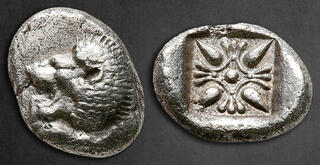| Savoca Numismatik GmbH & Co. KG > Online Auction 209 | Silver | Auction date: 28 April 2024 |
| Lot number: 124 Price realized: 80 EUR (Approx. 86 USD) Note: Prices do not include buyer's fees. | Show similar lots on CoinArchives Find similar lots in upcoming auctions on |
| Lot description: Ionia. Miletos circa 525-475 BC. Diobol AR 10 mm, 1,21 g Forepart of lion to right, his head turned back to left / Star-shaped floral ornament within incuse square. Very Fine Klein 424; SNG Keckman 273; SNG von Aulock 2080. The early coinage of Miletus holds significant historical and numismatic importance, as Miletus was one of the earliest Greek cities to issue coins. Miletus, located on the western coast of Asia Minor (modern-day Turkey), was a thriving center of trade and commerce in the ancient world, making its coinage influential throughout the Mediterranean. The earliest coins of Miletus date back to the 6th century BC and were made of electrum, a natural alloy of gold and silver commonly found in the region. These early coins were typically of a bean or oblong shape, and they often featured simple designs, such as incuse punches or geometric patterns. As coinage evolved, Miletus began producing more standardized coins with inscriptions and images that reflected the city's cultural and economic interests. A common motif was the lion, the star and crescent. Miletian coinage played a crucial role in facilitating trade and economic exchange in the ancient world. The widespread circulation of Miletian coins attests to the city's prominence as a center of commerce and its extensive networks of trade with other Greek cities, as well as with neighboring civilizations such as the Lydians, Persians, and Egyptians. Starting price: 50 EUR |  |


